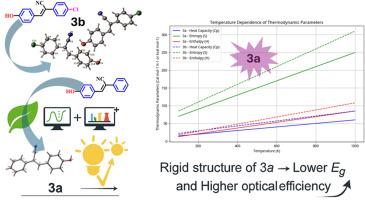揭示用于有机半导体的丙烯腈衍生物的温度依赖光电性能:综合DFT和实验分析
IF 4.9
3区 材料科学
Q2 CHEMISTRY, MULTIDISCIPLINARY
引用次数: 0
摘要
本研究从两个新合成的羟基取代苯丙烯腈衍生物(3a和3b)的合成入手,研究了它们的光电性质、晶体结构和热力学行为。实验结果表明,化合物3a具有优异的光学半导体潜力,特别是由于其较低的带隙值。为了更好地理解这种优势的机制,在室温和温度范围内,使用密度泛函理论(DFT)系统地计算了分子的热力学性质,包括热容量、熵、焓和总能量。虽然分子动力学和非辐射衰变之间的关系在文献中得到了承认,但温度相关热力学参数对有机半导体光电性能的定量影响,以及这种影响背后的机制,仍然没有得到充分的探讨。本研究通过证明与3b相比,化合物3a较低的热容量、焓和熵值与分子动力学降低直接相关,从而提高了光学效率,从而解决了这一空白。将电子结构与热力学刚性联系起来表明,化合物3a的振动自由度降低延长了激子寿命,阐明了温度依赖的衰变途径,并突出了其作为柔性光电有源层的前景。本文章由计算机程序翻译,如有差异,请以英文原文为准。

Unveiling the temperature-dependent optoelectronic performance of acrylonitrile derivatives for organic semiconductors: A comprehensive DFT and experimental analysis
This study investigates the optoelectronic properties, crystal structures, and thermodynamic behaviors of two newly synthesized hydroxy-substituted phenylacrylonitrile derivatives (3a and 3b), starting from their synthesis. Experimental findings demonstrate that compound 3a exhibits superior optical semiconductor potential, particularly due to its lower band gap values. To better understand the mechanisms responsible for this superiority, the thermodynamic properties of the molecules—including heat capacity, entropy, enthalpy, and total energy—were systematically calculated using Density Functional Theory (DFT) at room temperature and over a temperature range. While the relationship between molecular dynamics and non-radiative decay is acknowledged in the literature, the quantitative impact of temperature-dependent thermodynamic parameters on the optoelectronic performance of organic semiconductors, as well as the mechanisms behind this effect, remains insufficiently explored. This research addresses this gap by demonstrating that the lower heat capacity, enthalpy, and entropy values of compound 3a, in comparison to 3b, are directly associated with reduced molecular dynamism and consequently enhanced optical efficiency. Linking electronic structure to thermodynamic rigidity reveals that reduced vibrational freedom in compound 3a extends exciton lifetimes, illuminating temperature‐dependent decay pathways and highlighting its promise as a flexible optoelectronic active layer.
求助全文
通过发布文献求助,成功后即可免费获取论文全文。
去求助
来源期刊
CiteScore
7.80
自引率
2.50%
发文量
605
审稿时长
40 days
期刊介绍:
The Journal of Physics and Chemistry of Solids is a well-established international medium for publication of archival research in condensed matter and materials sciences. Areas of interest broadly include experimental and theoretical research on electronic, magnetic, spectroscopic and structural properties as well as the statistical mechanics and thermodynamics of materials. The focus is on gaining physical and chemical insight into the properties and potential applications of condensed matter systems.
Within the broad scope of the journal, beyond regular contributions, the editors have identified submissions in the following areas of physics and chemistry of solids to be of special current interest to the journal:
Low-dimensional systems
Exotic states of quantum electron matter including topological phases
Energy conversion and storage
Interfaces, nanoparticles and catalysts.

 求助内容:
求助内容: 应助结果提醒方式:
应助结果提醒方式:


